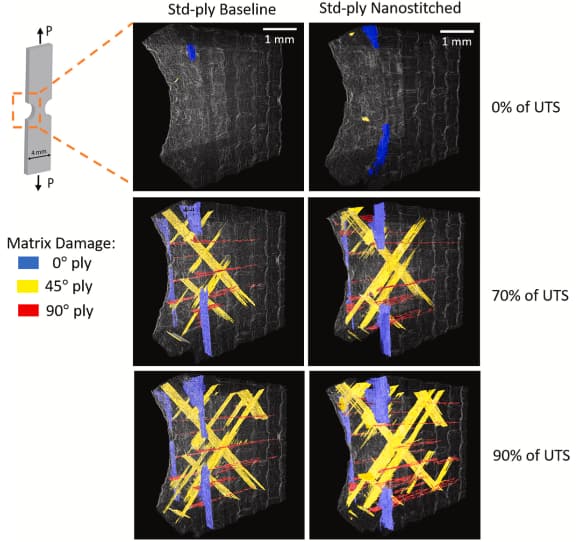- Home
- Industry
- Industry news
- Tomography provides...
Tomography provides quantitative measure of damage progression in carbon fibre composites under load
07-05-2021
Researchers from MIT stretched novel carbon fibre composites using an in situ loading rig and followed damage progression with tomography at beamline ID19.
Share
Advanced composite laminates comprised of carbon fibre reinforced plastic (CFRP) are extensively used by the aerospace industry because of their high in-plane mechanical performance and low weight. The researchers wanted to test two technical advancements in composite design, thin-ply composite laminates vs standard ply, and reinforcement of the interlaminar regions with high densities of aligned carbon nanotubes in a hierarchical architecture termed ‘nanostitching’.
High-resolution synchrotron radiation computed tomography (SRCT) is a powerful tool to non-destructively characterise the interior of materials. It provides an opportunity to follow 3D damage nucleation and progression in materials under increasing load.
At beamline ID19, CFRP samples were placed in an in situ loading rig and subjected to uniaxial tensile loading in steps up to 90% of their baseline ultimate tensile strength (UTS). A sub-micron pixel size was chosen for the SRCT to resolve the 7 μm diameter carbon fibres with about 1 μm wide matrix between the fibres. The samples were scanned at various load steps to reveal the damage state progression up to around 90% of their ultimate tensile strength (UTS). Software for three-dimensional visualisation and segmentation was used to classify and quantify dominant damage micro-mechanisms, which were identified as matrix cracking and fibre/matrix interfacial debonding.
In situ mechanical testing via SRCT proved to be a powerful means to visualise and quantify in 3D the progressive damage within the samples during loading. The 3D surface area of damaged regions could be calculated and used to compare the samples at various steps of loading. Analysis of the results revealed that the thin-ply composites had a significantly lower degree of damage to the standard-ply composites, confirming that the thin-ply morphology reduces damage progression. Furthermore, the carbon nanotube reinforced composites were also resistant to damage and only revealed relatively minor delamination within the limits of this study while providing a 9% increase in ultimate tensile strength over the standard-ply composite.
Reference
In situ synchrotron computed tomography study of nanoscale interlaminar reinforcement and thin-ply effects on damage progression in composite laminates, X. Ni, R. Kopp, E. Kalfon-Cohen, C. Furtado, J. Lee, A. Arteiro, G. Borstnar, M.N. Mavrogordato, L. Helfen, I. Sinclair, S.M. Spearing, P.P. Camanho, B.L. Wardle, Composites Part B: Engineering 217, 108623 (2021); doi: 10.1016/j.compositesb.2021.108623.




